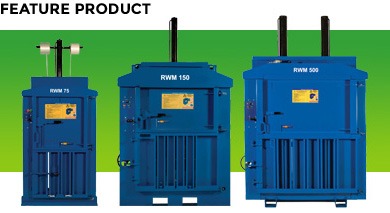Did you know that there are 10 simple steps you can take to ensure top waste baler performance? To minimise downtime, maximise safety and avoid unexpected repair costs, follow this quick guide and enjoy optimum running conditions.
- Nominate at least one member of staff who will be responsible for planned preventative maintenance. Segment tasks according to what needs to be carried out on a daily, monthly and annual basis, document the regime and stick to it.
- Even the most robust waste balers require you to keep your eyes peeled, so don’t overlook the obvious. Every morning, conduct visual inspections, inside and out, then act on anything that isn’t normal. If a pool of oil is spotted, however small, for example, do not use the machine until the source of the leak has been identified. Unplug the machine and report the leak to the appropriate supervisor/operations manager. A trained operative can then attempt to locate the reason for the leak. If a hydraulic fitting has come loose, a simple tightening may fix the issue. If the hydraulic fitting is damaged, contact an organisation such as Riverside Waste Machinery to schedule a repair.
- Keep the waste baler clean. At the end of each day, remove any excess materials/debris from inside or around the machine to avoid any disruption to the cycle process during the next shift.
- Once a month, check the oil levels in the tank on top of the machine, and top up if it is not in the mid to upper range on the gauge. Keep hydraulic oil in stock so there is a plentiful supply when required.
- Conduct a basic monthly lubrication regime, to ensure the hinges and turnbuckles, for example, are well greased. This needn’t take any more than five to ten minutes but will keep the baler running smoothly. Consider the environment that the baler is situated in. If the machine is outside and exposed to the elements, or it is located in a dry and dusty indoor setting, it may need lubricating more often than if it is in a normal aerated room.
- Check that the top and bottom doors are making sufficient contact with their respective safety valves and switches. Adjust the bolts if necessary.
- Inspect electrical cables and hydraulic hoses for signs of wear and tear. If any damage or deterioration is apparent, source a replacement part from a waste baler specialist such as Riverside, as soon as possible.
- Once a year, book the baler in for a comprehensive 24-point service, which can be carried out by a waste machinery specialist like Riverside. This will help to proactively uncover any underlying issues that might disrupt future operations if they go unaddressed.
- Ensure operators are fully trained, and if any new team members are required to use the machine, don’t rely on colleagues to pass on their knowledge. Very much like Chinese whispers, information can become lost or distorted along the way. So, invest in certified baler training to equip everyone with the skills they need.
- Know when to rely on the experts. You’ll be able to carry out many maintenance tasks using the expertise within your own team, but for more complex repairs or rigorous machine inspections, the input of waste baler specialists is required. Have a ‘go to’ supplier and ensure their contact details are clearly marked on the machine in the event of an emergency. It also goes without saying that any electrical works must be carried out by a qualified electrician/electrical engineer.
To discuss the servicing, maintenance, upkeep, or refurbishment of your waste baler, contact our team of baling experts on 01423 325038 or email services@wastemachinery.co.uk.






